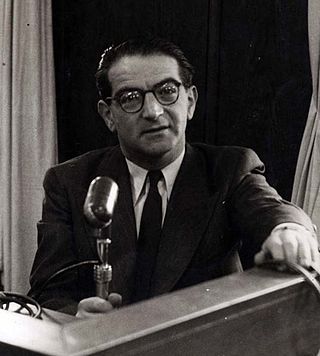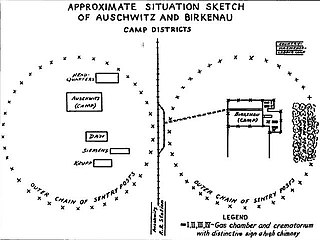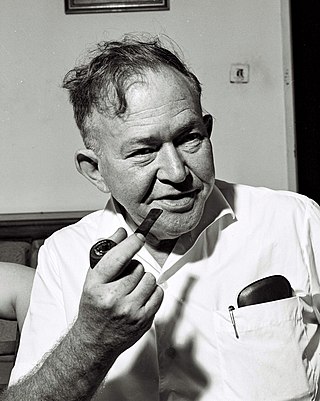
Rezső Kasztner, also known as Rudolf Israel Kastner, was a Hungarian-Israeli journalist and lawyer who became known for having helped a group of Jews escape from occupied Europe during the Holocaust on the Kastner train. After World War II, he was accused of having failed to informed the majority of Hungarian Jews about the reality of what awaited them in Auschwitz. He was assassinated in 1957 after an Israeli court accused him of having "sold his soul to the devil," a charge that was overturned by the Supreme Court of Israel in 1958.

Siegfried Seidl was an Austrian career officer and World War II commandant of the Theresienstadt concentration camp located in the present-day Czech Republic. He was also the commandant of the Bergen-Belsen, and later served as a staff officer to Adolf Eichmann. After the war, Seidl was tried in Austria and convicted as a war criminal, sentenced to death, and executed by hanging.

The Vrba–Wetzler report is one of three documents that comprise what is known as the Auschwitz Protocols, otherwise known as the Auschwitz Report or the Auschwitz notebook. It is a 33-page eye-witness account of the Auschwitz concentration camp in German-occupied Poland during the Holocaust.

Rudolf Vrba was a Slovak-Jewish biochemist who, as a teenager in 1942, was deported to the Auschwitz concentration camp in German-occupied Poland. He escaped from the camp in April 1944, at the height of the Holocaust, and co-wrote the Vrba-Wetzler report, a detailed report about the mass murder taking place there. The report, distributed by George Mantello in Switzerland, is credited with having halted the mass deportation of Hungary's Jews to Auschwitz in July 1944, saving more than 200,000 lives. After the war, Vrba trained as a biochemist, working mostly in England and Canada.

Joel Brand was a member of the Budapest Aid and Rescue Committee, an underground Zionist group in Budapest, Hungary, that smuggled Jews out of German-occupied Europe to the relative safety of Hungary, during the Holocaust. When Germany invaded Hungary in March 1944, Brand became known for his efforts to save the Jewish community from deportation to the Auschwitz concentration camp in occupied Poland and the gas chambers there.

Kurt Andreas Ernst Becher was a mid-ranking SS commander who was Commissar of all German concentration camps, and Chief of the Economic Department of the SS Command in Hungary during the German occupation in 1944. He is best known for having traded Jewish lives for money during the Holocaust.

The Aid and Rescue Committee, or Va'adat Ha-Ezrah ve-ha-Hatzalah be-Budapesht was a small committee of Zionists in Budapest, Hungary, in 1944–1945, who helped Hungarian Jews escape the Holocaust during the German occupation of that country. The Committee was also known as the Rescue and Relief Committee, and the Budapest Rescue Committee.
The Abandonment of the Jews: America and the Holocaust 1941–1945 is a 1984 nonfiction book by David S. Wyman, former Josiah DuBois professor of history at the University of Massachusetts Amherst. Wyman was the chairman of the David S. Wyman Institute for Holocaust Studies. The Abandonment of the Jews has been well received by most historians, and has won numerous prizes and widespread recognition, including a National Jewish Book Award, the Anisfield-Wolf Award, the Present Tense Literary Award, the Stuart Bernath Prize from the Society for Historians of American Foreign Relations, and the Theodore Saloutos Award of the Immigration History Society, and was nominated for the National Book Critics Circle Award."
Perdition is a 1987 stage play by Jim Allen. Its premiere at London's Royal Court Theatre Upstairs, in a production directed by Ken Loach, was abandoned because of protests, and criticism by two historians, over its controversial and tendentious claims.

Otto Adolf Eichmann was a German-Austrian official of the Nazi Party, an officer of the Schutzstaffel (SS), and one of the major organisers of the Holocaust. He participated in the January 1942 Wannsee Conference, at which the implementation of the genocidal Final Solution to the Jewish Question was planned. Following this, he was tasked by SS-Obergruppenführer Reinhard Heydrich with facilitating and managing the logistics involved in the mass deportation of millions of Jews to Nazi ghettos and Nazi extermination camps across German-occupied Europe. He was captured and detained by the Allies in 1945, but escaped and eventually settled in Argentina. In May 1960, he was tracked down and apprehended by Israel's Mossad intelligence agency, and put on trial before the Supreme Court of Israel. The highly publicised Eichmann trial resulted in his conviction in Jerusalem, following which he was executed by hanging in 1962.

Ladislaus Löb was a writer, translator, Holocaust survivor, scholar of the literature and drama of the German Enlightenment and Professor Emeritus of German at the University of Sussex in England. He was the author of From Lessing to Hauptmann: Studies in German Drama (1974); a monograph, in German, on the nineteenth-century dramatist Christian Dietrich Grabbe (1996); and Dealing with Satan: Rezső Kasztner's Daring Rescue Mission (2008), in which he recounts his experiences an 11-year old boy sent to Bergen-Belsen concentration camp and freed as the result of a controversial deal that Rezső Kasztner brokered with Adolf Eichmann.

The Attorney-General of the Government of Israel v. Malchiel Gruenwald, commonly known as the Kastner trial, was a libel case in Jerusalem, Israel. Hearings were held from 1 January to October 1954 in the District Court of Jerusalem before Judge Benjamin Halevi (1910–1996), who published his decision on 22 June 1955.
Egon Mayer was a Swiss-born American sociologist and professor at Brooklyn College. He wrote a number of books on Jewish culture and history, including From Suburb to Shtetl (1979), The Court Jew: A Contribution to the History of Absolutism in Europe (1984), and Love and Tradition: Marriage Between Jews and Christians (1985).

Hajnalka "Hansi" Brand was a Hungarian-born Zionist activist who was involved, as a member of the Budapest Aid and Rescue Committee, in efforts to rescue Jews during the Holocaust.

The Holocaust in Hungary was the dispossession, deportation, and systematic murder of more than half of the Hungarian Jews, primarily after the German occupation of Hungary in March 1944.
Izhak Weinberg is one of the youngest Holocaust survivors, who lost all his family of 60 souls in a single day. He and his younger brother hid for several years in different villages in Europe and survived. Weinberg built an amazing life full of meaning and art.

The Working Group was an underground Jewish organization in the Axis-aligned Slovak State during World War II. Led by Gisi Fleischmann and Rabbi Michael Dov Weissmandl, the Working Group rescued Jews from the Holocaust by gathering and disseminating information on the Holocaust in Poland, bribing and negotiating with German and Slovak officials, and smuggling valuables to Jews deported to Poland.
Pinchas Freudiger, also Fülöp Freudiger, Philip von Freudiger was a Hungarian-Israeli manufacturer and Jewish community leader.

József Fischer was a Hungarian and Romanian lawyer and politician of Jewish ethnicity. He was a prominent leader of the Jewish National Party in interwar Romania. In this capacity, he was a member of the Assembly of Deputies from 1928 to 1933. He served as head of the Judenrat in Kolozsvár Ghetto during the Holocaust.
Béla Schwartz was a Hungarian Jewish leader during the World War II. Following the German invasion of Hungary, he served as president of the Judenrat in Kisújszállás.


















